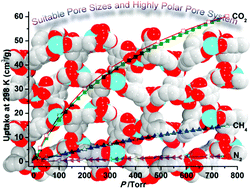Selective CO2 adsorption in a microporous metal–organic framework with suitable pore sizes and open metal sites†
Abstract
Microporous metal–organic frameworks, [H2N(Me)2]2[Zn4(L)2(H2O)1.5]·5DMF·H2O (1·DMF) or [H2N(Me)2]2[Zn4(L)2(H2O)1.5]·4DMA·6H2O (1·DMA), have been synthesized under solvothermal conditions using an undeveloped asymmetrical pentacarboxylate ligand, 2,4-di(3′,5′-dicarboxylphenyl)benzoic acid (H5L). Structural analysis demonstrates that 1 is a 3D anionic framework based on two kinds of dinuclear [Zn2(COO)5(H2O)] secondary building units (SBUs), which presents a rare framework constructed from ternary SBUs and shows a new (5,5,5)-connected topology. The desolvated anionic structure of 1·DMF (1a) contains two shapes of 1D channel with suitable pore sizes and a highly polar pore system decorated with open metal sites, diethylammonium cations and carboxylic oxygen atoms, exhibiting multipoint interactions between CO2 molecules and the framework, resulting in high CO2 uptake and significant selectivity for CO2 over CH4 and N2. In addition, 1·DMF and 1·DMA display solid-state photoluminescence stemming from the ligand-centered fluorescent emissions of H5L.


 Please wait while we load your content...
Please wait while we load your content...